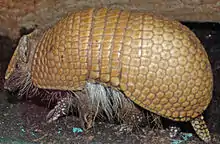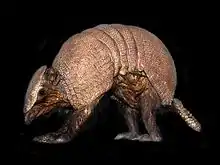Tolypeutes
The genus Tolypeutes contains the two species of three-banded armadillos. They are restricted to open and semi-open habitats in South America.
| Tolypeutes | |
|---|---|
 | |
| Southern three-banded armadillo | |
| Scientific classification | |
| Kingdom: | Animalia |
| Phylum: | Chordata |
| Class: | Mammalia |
| Order: | Cingulata |
| Family: | Chlamyphoridae |
| Subfamily: | Tolypeutinae |
| Genus: | Tolypeutes Illiger, 1811 |
| Species | |
|
See text | |
Of the several armadillo genera, only Tolypeutes rely heavily on their armor for protection. When threatened by a predator, Tolypeutes species frequently roll up into a ball. Other armadillo species cannot roll up because they have too many plates.
Species
There are two recognized species:[1]
| Image | Scientific name | Common Name | Distribution |
|---|---|---|---|
 | Tolypeutes matacus (Desmarest, 1804) | Southern three-banded armadillo | northern Argentina, southwestern Brazil, Paraguay and Bolivia |
 | Tolypeutes tricinctus (Linnaeus, 1758) | Brazilian three-banded armadillo | Brazil |
References
- "Tolypeutes". Integrated Taxonomic Information System. Retrieved 17 March 2011.
This article is issued from Wikipedia. The text is licensed under Creative Commons - Attribution - Sharealike. Additional terms may apply for the media files.